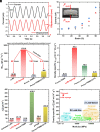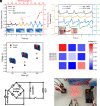The giant flexoelectric effect in a luffa plant-based sponge for green devices and energy harvesters
- PMID: 37748078
- PMCID: PMC10556619
- DOI: 10.1073/pnas.2311755120
The giant flexoelectric effect in a luffa plant-based sponge for green devices and energy harvesters
Abstract
Soft materials that can produce electrical energy under mechanical stimulus or deform significantly via moderate electrical fields are important for applications ranging from soft robotics to biomedical science. Piezoelectricity, the property that would ostensibly promise such a realization, is notably absent from typical soft matter. Flexoelectricity is an alternative form of electromechanical coupling that universally exists in all dielectrics and can generate electricity under nonuniform deformation such as flexure and conversely, a deformation under inhomogeneous electrical fields. The flexoelectric coupling effect is, however, rather modest for most materials and thus remains a critical bottleneck. In this work, we argue that a significant emergent flexoelectric response can be obtained by leveraging a hierarchical porous structure found in biological materials. We experimentally illustrate our thesis for a natural dry luffa vegetable-based sponge and demonstrate an extraordinarily large mass- and deformability-specific electromechanical response with the highest-density-specific equivalent piezoelectric coefficient known for any material (50 times that of polyvinylidene fluoride and more than 10 times that of lead zirconate titanate). Finally, we demonstrate the application of the fabricated natural sponge as green, biodegradable flexible smart devices in the context of sensing (e.g., for speech, touch pressure) and electrical energy harvesting.
Keywords: energy harvester; flexible sensor; flexoelectricity; green device; luffa plant-based sponge.
Conflict of interest statement
The authors declare no competing interest.
Figures





Similar articles
-
Nonlinear bending deformation of soft electrets and prospects for engineering flexoelectricity and transverse (d31) piezoelectricity.Soft Matter. 2018 Dec 19;15(1):127-148. doi: 10.1039/c8sm01664j. Soft Matter. 2018. PMID: 30539952
-
Flexoelectricity in soft elastomers and the molecular mechanisms underpinning the design and emergence of giant flexoelectricity.Proc Natl Acad Sci U S A. 2021 May 25;118(21):e2102477118. doi: 10.1073/pnas.2102477118. Proc Natl Acad Sci U S A. 2021. PMID: 34021089 Free PMC article.
-
Advancements and Prospects of Flexoelectricity.ACS Appl Mater Interfaces. 2024 Feb 28;16(8):9597-9613. doi: 10.1021/acsami.3c16727. Epub 2024 Feb 15. ACS Appl Mater Interfaces. 2024. PMID: 38357861 Review.
-
A flexoelectricity-enabled ultrahigh piezoelectric effect of a polymeric composite foam as a strain-gradient electric generator.Sci Adv. 2023 Jan 13;9(2):eadc8845. doi: 10.1126/sciadv.adc8845. Epub 2023 Jan 13. Sci Adv. 2023. PMID: 36638177 Free PMC article.
-
Flexoelectricity in two-dimensional crystalline and biological membranes.Nanoscale. 2015 Oct 28;7(40):16555-70. doi: 10.1039/c5nr04722f. Nanoscale. 2015. PMID: 26399878 Review.
Cited by
-
Free vibration of nanobeams with surface and dynamic flexoelectric effects.Sci Rep. 2024 Dec 4;14(1):30192. doi: 10.1038/s41598-024-82002-9. Sci Rep. 2024. PMID: 39632965 Free PMC article.
-
Fundamentals of Flexoelectricity, Materials and Emerging Opportunities Toward Strain-Driven Nanocatalysts.Small. 2024 Dec;20(52):e2406726. doi: 10.1002/smll.202406726. Epub 2024 Nov 6. Small. 2024. PMID: 39501989 Free PMC article. Review.
-
Bending and vibration behavior of functionally graded piezoelectric nanobeams considering dynamic flexoelectric and surface effects.Sci Rep. 2025 Apr 18;15(1):13439. doi: 10.1038/s41598-025-98080-2. Sci Rep. 2025. PMID: 40251344 Free PMC article.
-
Ultrafast universal fabrication of configurable porous silicone-based elastomers by Joule heating chemistry.Proc Natl Acad Sci U S A. 2024 Mar 12;121(11):e2317440121. doi: 10.1073/pnas.2317440121. Epub 2024 Mar 4. Proc Natl Acad Sci U S A. 2024. PMID: 38437532 Free PMC article.
References
-
- Xie L., et al. , Intelligent wearable devices based on nanomaterials and nanostructures for healthcare. Nanoscale 15, 405–433 (2023). - PubMed
-
- Romasanta L. J., Verdejo R., Increasing the performance of dielectric elastomer actuators: A review from the materials perspective. Prog. Polym. Sci. 51, 188–211 (2015).
-
- Radousky H. B., Liang H., Energy harvesting: An integrated view of materials, devices and applications. Nanotechnology 23, 502001 (2012). - PubMed
-
- Bowen C. R., Kim H. A., Weaver P. M., Dunn S., Piezoelectric and ferroelectric materials and structures for energy harvesting applications. Energy Environ. Sci. 7, 25–44 (2014).
Grants and funding
LinkOut - more resources
Full Text Sources
Medical

